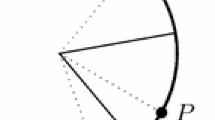Abstract
Under standard assumptions equilibria with three parties normally do not exist in spatial models of electoral competition. In this paper I show that such equilibria are possible if it is assumed that voters are uncertain about the exact policies parties will adopt once elected. Substantive predictions can be derived from the model, explaining some features of three-party competition. First, the least risk party will always take the most moderate position. Second, this position is also winning. Third, the two riskier parties are always on opposite sides of the median voter and also of the moderate party.
Similar content being viewed by others
References
Austen-Smith, D. and Banks, J.S. (1988). Elections, coalitions, and legislative outcomes.American Political Science Review 82: 405–422.
Banks, J.S. (1990). A model of electoral competition with incomplete information.Journal of Economic Theory 50: 309–325.
Bernhardt, M.D. and Ingberman, D.E. (1985). Candidate reputations and the ‘incumbency effect’.Journal of Public Economics 27: 47–67.
Bogdanor, V. (1981). The Social Democrats and the Constitution (Difficulties confronting the newly formed party).Political Quarterly 52: 285–294.
Dasgupta, P. and Maskin, E. (1986a). The existence of equilibrium in discontinuous economic games, I: Theory.Review of Economic Studies 53: 1–26.
Dasgupta, P. and Maskin, E. (1986b). The existence of equilibrium in discontinuous economic games, II: Applications.Review of Economic Studies 53: 27–41.
Eaton, B.C. and Lipsey, R.G. (1975). The principle of minimum differentiation reconsidered: Some new developments in the theory of spatial competition.Review of Economic Studies 42: 27–49.
Enelow, J.H. and Hinich, M.J. (1981). A new approach to voter uncertainty in the Downsian spatial model.American Journal of Political Science 25: 483–493.
Enelow, J.H. and Hinich, M.J. (1984).The spatial theory of voting: An introduction. Cambridge: Cambridge University Press.
Feddersen, T.J., Sened, I. and Wright, S.G. (1990). Rational voting and candidate entry under plurality rule.American Journal of Political Science 34: 1005–1016.
Franklin, C.H. (1991). Eschewing obfuscation?: Campaigns and the perception of Senate incumbents.American Political Science Review 85: 1193–1214.
Greenberg, J. and Shepsle, K.A. (1987). The effect of electoral rewards in multi-party competition with entry.American Political Science Review 81: 525–537.
Hermsen, H. and Verbeek, A. (1992), Equilibria in multi-party systems.Public Choice 73: 147–166.
Lemieux, P.H. (1977). Political issues and liberal support in the February 1974 British General Election.Political Studies 25: 323–342.
Osborne, M.J. (1992). Candidate positioning and entry in a political competition. Hamilton, Ontario: Department of Economics, McMaster University (Working Paper No. 92-09).
Palfrey, T.R. (1984). Spatial equilibrium with entry.Review of Economic Studies 51: 139–156.
Pinard, M. (1967). One-party dominance and third parties.Canadian Journal of Economics and Political Science 33: 358–373.
Rosenstone, S.J., Behr, R.L. and Lazarus, E.H. (1984).Third parties in America. Princeton: Princeton University Press.
Shaked, A. (1982). Existence and computation of mixed strategy nash equilibrium for 3-firms location problem.Journal of Industrial Economics 31: 93–96.
Shepsle, K.A. (1972a). Parties, voters, and the risk environment: A mathematical treatment of electoral competition under uncertainty. In R.G. Niemi and H.F Weisberg (Eds.),Probability models of collective decision-making, 273–297. Columbus: Merrill.
Shepsle, K.A. (1972b). The strategy of ambiguity: Uncertainty and electoral competition.American Political Science Review 66: 555–568.
Shepsle, K.A. (1991).Models of multiparty competition. London: Harwood.
Shepsle, K.A. and Cohen, R.N. (1990). Multiparty competition, entry, and entry deterrence in spatial models of elections. In J.M. Enelow and M.J. Hinich (Eds.),Advances in the spatial theory of voting. Cambridge: Cambridge University Press.
Author information
Authors and Affiliations
Additional information
This is a heavily revised version of the paper “Uncertainty and New Political Parties,” prepared for presentation at the Annual Meeting of the Midwest Political Science Association, Chicago 1992. Thanks to Chris Achen, Jeff Banks, Lars-Erik Cederman, Douglas Dion, Joel Kaji, Martin Osborne, Gerald Schneider and an anonymous reviewer for their extremely helpful remarks. While almost all interesting and important ideas of this paper are theirs, the remaining errors, shortcomings and not-so-good ideas are all mine.
Rights and permissions
About this article
Cite this article
Hug, S. Third parties in equilibrium. Public Choice 82, 159–180 (1995). https://doi.org/10.1007/BF01047735
Accepted:
Issue Date:
DOI: https://doi.org/10.1007/BF01047735




